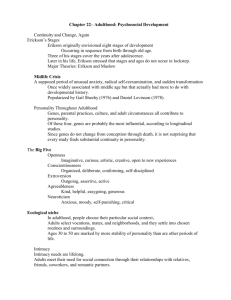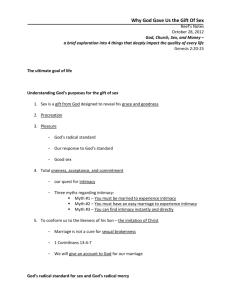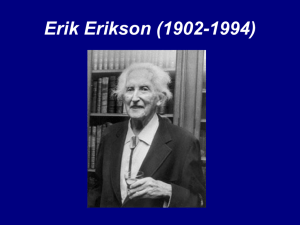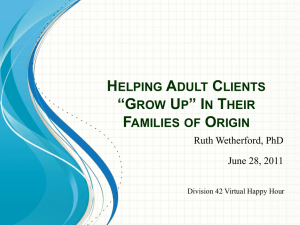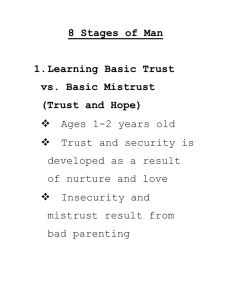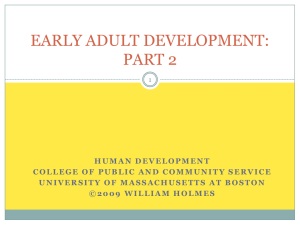Part VII Adulthood: Psychosocial Development Chapter Twenty-Two Ages and Stages
advertisement
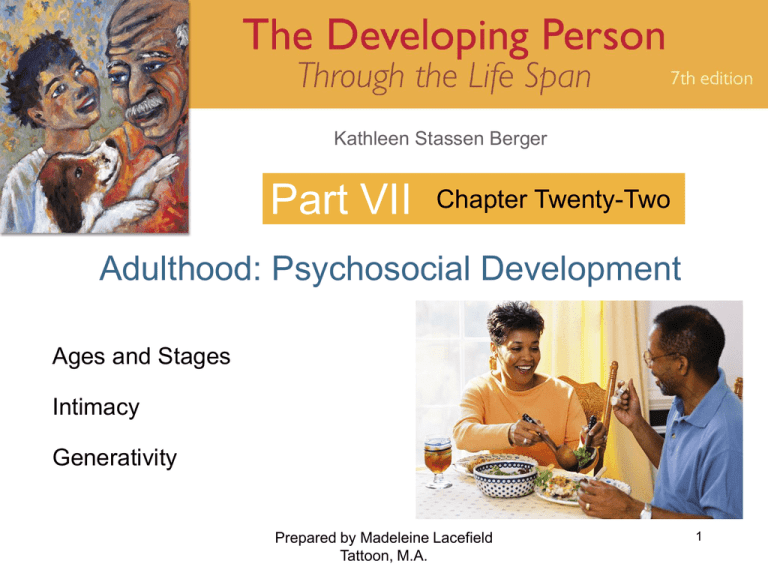
Kathleen Stassen Berger Part VII Chapter Twenty-Two Adulthood: Psychosocial Development Ages and Stages Intimacy Generativity Prepared by Madeleine Lacefield Tattoon, M.A. 1 Adulthood: Psychosocial Development • emotional reactions to events in adulthood are fluid • marriage, parenthood, divorce, and the empty nest, each sometimes joyous and sometimes not, are ages and stages of adult development 2 Ages and Stages 3 Ages and Stages • The Social Clock – refers to the idea that the stages of life, and the behaviors “appropriate” to them, are set by social standards rather than by biological maturation—for instance, ”middle age” begins when the culture believes it does, rather than at a particular age in all cultures 4 Ages and Stages • Culture, Cohort, and SES – culture • the patterns of behavior that are passed from one generation to the next, groups have their own culture— values, customs, clothes, dwellings, cuisine, assumptions--people are influenced by more than one culture – cohort • people born within a few years of one another--these people are affected by the same: values, events, technologies, culture – socioeconomic status (SES) • “social class”--more than money, occupation, education, place of residence--includes advantages and disadvantages 5 Ages and Stages • The “Midlife Crisis” – a period of unusual anxiety, radical reexamination, and sudden transformation that is widely associated with middle age but which actually has more to do with developmental history than with chronological age 6 Ages and Stages • Personality Throughout Adulthood – personality is a major source of continuity providing coherence and identity, allowing people to know themselves and be known 7 Ages and Stages • The Big Five – the five basic clusters of personality traits that remain quite stable throughout adulthood— openness, conscientiousness, extroversion, agreeableness and neuroticism – ecological niche • the particular lifestyle and social context adults settle into that are compatible with their individual personality needs and interests 8 Ages and Stages • Culture and Personality – personality variations are more evident between one person and another in the same nation than between one nation and another 9 Ages and Stages • Gender Convergence – a tendency for men and women to become more similar as they move through middle age 10 Intimacy • intimacy needs are lifelong • adults meet their social needs for social connection with relatives, friends, coworkers, and romantic partners – social convoy – collectively, the family members, friends, acquaintances, and even strangers who move through life with an individual 11 Intimacy • Friends – typically the most supportive members of the social convoy, because they are chosen – research study found that friendships tend to improve with age 12 Intimacy • Protection Against Stress – allostatic load • the total, combined burden, of stress and disease that an individual must cope with 13 Intimacy • Gender Differences – linked lives • the notion that family members tend to share all aspects of each other’s lives, from triumph to tragedy 14 Intimacy • Family Bonds – household • a group of people who live together in one dwelling and share its common spaces, such as kitchen and living room 15 Intimacy • A Developmental View – familism • the idea that family members should support one another because family unity is more important than individual freedom and success or failure 16 Intimacy • Adult Siblings – fictive kin • a term used to describe someone who becomes accepted as part of a family to whom he or she has no blood relationship 17 Intimacy • Marriage – a public commitment to one long-term sexual partner – adults seek committed sexual partnerships to help meet their needs for intimacy, to raise children, share resources, and provide care 18 Intimacy • Marriage and Happiness – from a developmental perspective, marriage is useful – adults thrive if another person is committed to caring for them; married people are a littler happier, healthier and richer than unmarried people 19 Intimacy • Long-Term Marriage – long-term quality of a marriage relationship is affected by family relationships in childhood – empty nest • a time in the lives of parents when their grown children leave the family home to pursue their own lives 20 Intimacy • Homosexual Partners – everything that applies to heterosexual partners applies to homosexual partners who make a commitment to each other 21 Intimacy • Divorce – marriages never ends in a vacuum—they are influenced by the social and political context • Divorce Rates – the power of the social context is evident in variations in divorce rates • Over the Years, Divorce and Remarriage – divorce is most likely to occur within the first five years – for long-term marriages, divorce is less likely but more devastating when it happens 22 Generativity • after intimacy comes generativity, – generativity versus stagnation • when adults seek to be productive in a caring way, usually through work or parenthood (Erikson) – generativity comes with maturity–age is not a necessary marker 23 Generativity • Caregiving – Erikson wrote, a mature adult “needs to be needed” – some caregiving is physical – but much is psychological – kinkeeper – the person who takes primary responsibility for celebrating family achievements, gathering the family together, and keeping in touch with family members who do not live nearby 24 Generativity • Caring for Children – bearing and raising children is labor intensive – the insistence on dramatizing the dependence of children on adults often blinds us to the dependence of the older generation on the young one 25 Generativity • Many paths to parenthood – a parental alliance assumes two cooperating parents – children can develop well in any family – 1/3 of North American adults become stepparents, adoptive parents, or foster parents at some point in their lives – the social construction about “real” parents is misleading 26 Generativity – Caregiving for Aging Parents • sandwich generation – a term for the generation of middle-aged people who are supposedly “squeezed” by the needs of the younger and older generations—some adults do feel pressured by these obligations, but most are not burdened by them, either because they enjoy fulfilling them or because they choose to take on only some of them, or none 27 Generativity • Employment – Many benefits • extrinsic rewards of work – the tangible rewards, usually in the form of compensation, that one receives for a job (e.g., salary, benefits, pension) • intrinsic rewards of work – the intangible benefits one receives from a job (e.g. job satisfaction, self-esteem, pride) that come from within oneself 28 Generativity • Human Needs – it is crucial to learn how new work conditions support development—in the functions of family caregiving, personal creativity, satisfaction, and esteem and mentoring of other workers 29 Generativity • Diversity – benefit of modern economy is increased diversity • more employed women and minority groups • higher employment rates have helped with those once shut out 30
